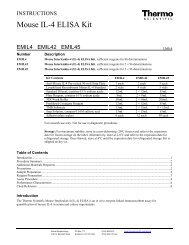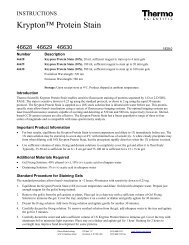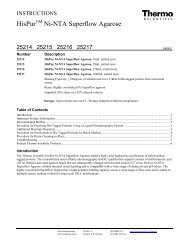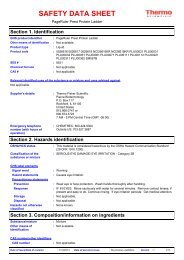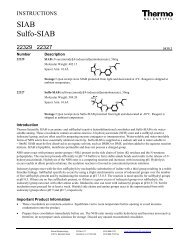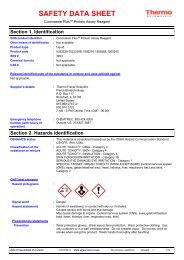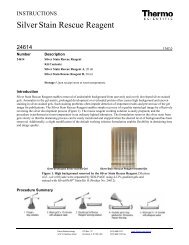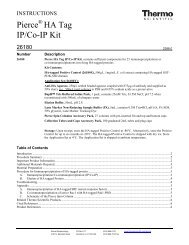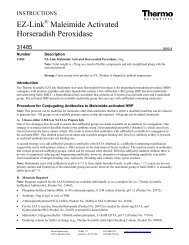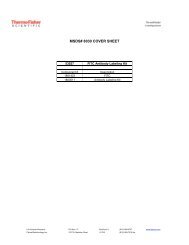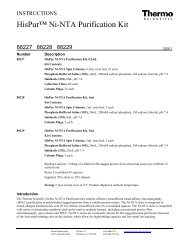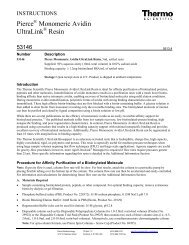Thermo Scientific Pierce Protein Assay Technical Handbook Version 2
Thermo Scientific Pierce Protein Assay Technical Handbook Version 2
Thermo Scientific Pierce Protein Assay Technical Handbook Version 2
You also want an ePaper? Increase the reach of your titles
YUMPU automatically turns print PDFs into web optimized ePapers that Google loves.
Modified Lowry <strong>Protein</strong> <strong>Assay</strong><br />
Advantages of the Modified Lowry <strong>Protein</strong> <strong>Assay</strong><br />
The final blue color is optimally measured at 750nm, but it can be<br />
measured at any wavelength between 650nm and 750nm with<br />
little loss of color intensity. It is best to measure the color at<br />
750nm because few other substances absorb light at that<br />
wavelength. The amount of light absorbed at 750nm is directly<br />
proportional to the amount of protein in the sample, but the color<br />
response curve produced is nonlinear. The sensitivity of the<br />
Modified Lowry <strong>Protein</strong> <strong>Assay</strong> is greatly enhanced over that of<br />
the biuret reagent. The working range of the method extends<br />
from 5 to 2,000mg/mL.<br />
The Modified Lowry <strong>Protein</strong> <strong>Assay</strong> demonstrates less<br />
protein:protein variability than Coomassie-based assays. When<br />
comparing the standard curve responses between BSA and BGG,<br />
there is less than a 15% variation in the signal generated with<br />
these two standard proteins (Figure 2). The Coomassie <strong>Protein</strong><br />
<strong>Assay</strong> demonstrates > 30% variation in the signal generated<br />
between BSA and BGG (Table 2, page 9).<br />
Net Absorbance (750nm)<br />
3<br />
2<br />
1<br />
0<br />
0<br />
500<br />
1,000<br />
1,500<br />
<strong>Protein</strong> Concentration (µg/mL)<br />
BSA<br />
BGG<br />
Figure 2. Color response curves obtained with the <strong>Thermo</strong> <strong>Scientific</strong> <strong>Pierce</strong><br />
Modified Lowry <strong>Protein</strong> <strong>Assay</strong> Reagent using bovine serum albumin (BSA) and<br />
bovine gamma globulin (BGG). The standard tube protocol was performed and<br />
the color was measured at 750nm.<br />
2,000<br />
Disadvantages of the Modified Lowry <strong>Protein</strong> <strong>Assay</strong><br />
The Modified Lowry <strong>Protein</strong> <strong>Assay</strong> will form precipitates in the<br />
presence of detergents or potassium ions. The problem of precipitation<br />
caused by the presence of potassium ions in the sample<br />
can sometimes be overcome by centrifuging the tube and measuring<br />
the color in the supernatant. Most surfactants will cause<br />
precipitation of the reagent even at very low concentrations.<br />
One exception is sodium dodecyl sulfate (SDS), which is compatible<br />
with the reagent at concentrations up to 1% in the sample.<br />
Chelating agents interfere by binding copper and preventing<br />
formation of the copper peptide bond complex. Reducing agents<br />
and free thiols also interfere by reducing the phosphotungstatephosphomolybdate<br />
complex, immediately forming an intensely<br />
blue colored product upon their addition to the Modified Lowry<br />
<strong>Protein</strong> <strong>Assay</strong> Reagent.<br />
General Characteristics of the Modified Lowry <strong>Protein</strong> <strong>Assay</strong><br />
The Modified Lowry <strong>Protein</strong> <strong>Assay</strong> Reagent must be refrigerated<br />
for long-term storage. If the entire bottle of reagent will be used<br />
within one month, it may be stored at room temperature (18-26°C).<br />
Reagent that has been left at room temperature for more than<br />
one month may produce lower color response, especially at the<br />
higher end of the working range. If the reagent has been stored<br />
refrigerated, it must be warmed to room temperature before use.<br />
Using cold Modified Lowry <strong>Protein</strong> <strong>Assay</strong> Reagent will result in<br />
low absorbance values.<br />
The protocol requires that the Folin phenol reagent be added to<br />
each tube precisely at the end of the 10-minute incubation. At<br />
the alkaline pH of the Lowry reagent, the Folin phenol reagent is<br />
almost immediately inactivated. Therefore, it is best to add the<br />
Folin phenol reagent at the precise time while simultaneously<br />
mixing each tube. Because this is somewhat cumbersome, some<br />
practice is required to obtain consistent results. This also limits<br />
the total number of samples that can be assayed in a single run.<br />
If a 10-second interval between tubes is used, the maximum<br />
number of tubes that can be assayed within 10 minutes is 60<br />
(10 seconds/tube x 60 tubes = 600 seconds or 10 minutes).<br />
28<br />
For more information, or to download product instructions, visit www.thermoscientific.com/pierce



